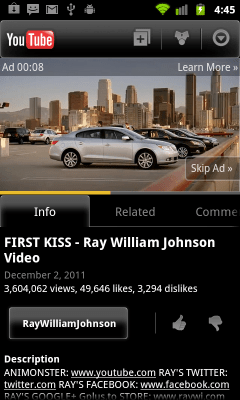Back at the end of 2010, YouTube officially launched its video ad format that viewers can actually skip. Today, it says 65 percent of the ads that play before videos are now skippable — and given that growth, it’s not surprising that YouTube is bringing the format to mobile.
Group Product Manager Phil Farhi tells me YouTube started to launch more ad formats on mobile about a year ago. Until now, however, the ads that played before mobile videos were traditional pre-rolls — in other words, you couldn’t skip them. Other ad formats under the broader TrueView umbrella were transferred to mobile earlier, but not the TrueView in-stream video ads, i.e., the skippable ones.
“The broad goal here is around aligning user experience and advertiser goals in a way that delivers a more accountable advertising platform to advertisers and the brand, as well as a better user experience,” Farhi says. (The “accountable advertising platform” bit comes in because advertisers only pay for ads that aren’t skipped.) He adds, “That model, the concept of only paying for engaged viewers who have a choice in what they watch, really applies across screens.”
YouTube says it has conducted a few small tests prior of skippable ads on mobile, but starting today, all TrueView in-stream campaigns will be mobile-enabled, as controlled through the AdWords For Video dashboard. The challenge, Farhi says, has been making sure that the controls work on the smaller screens of mobile.
As YouTube starts running more mobile campaigns in this format, Farhi says it will be looking at the data to see if users engage differently with different types of ads depending on the platform — if they do, YouTube may try to help advertisers optimize their campaigns so that their promoting the best content for each platform.
Of course, the big news for YouTube has been the fact that the YouTube app won’t come pre-loaded on iOS 6. As a number of writers noted at the time, the move could end up being beneficial for Google, which hasn’t been able to monetize the videos viewed on the pre-installed iOS app through advertising. (Instead, all of its mobile monetization efforts have come through the mobile web and non-preloaded apps like Vevo.) So the switch to a YouTube app that’s made entirely by Google, and that users have to install, is probably paving the way for a bigger push in mobile monetization.
